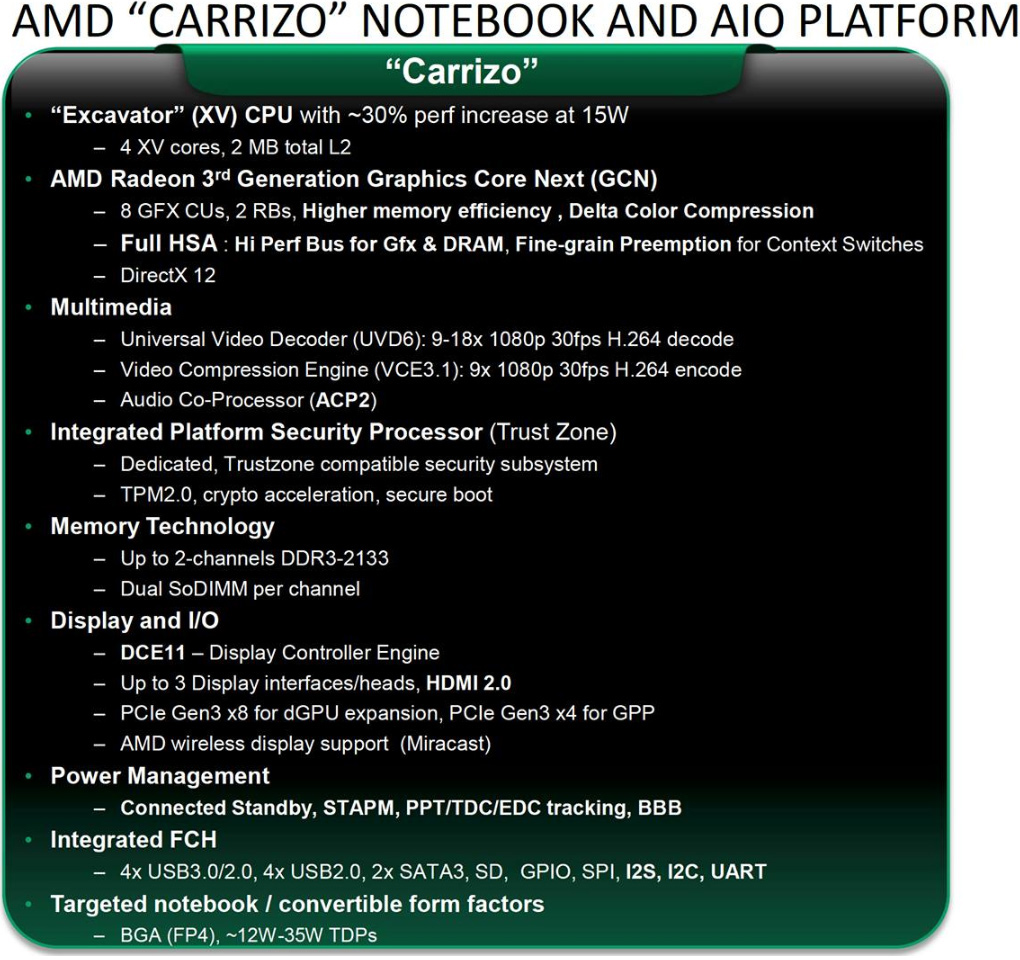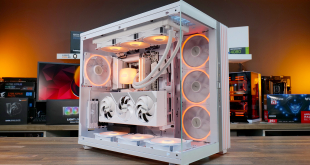Although AMD’s next-generation accelerated processing unit (APU) code-named “Carrizo” employs the company’s upcoming high-performance “Excavator” x86 cores, they may never make it to high-performance desktop computers as AMD tailored its forthcoming APUs specifically for mobile devices.
In order to cut-down power consumption of “Carrizo” chips compared to current-generation “Kaveri” APUs, AMD and GlobalFoundries had to make changes to 28nm super high performance (SHP) process technology. The new wiring line of the process that is used to manufacturer AMD’s “Carrizo” APUs helps to reduce power consumption of the chip, but does not allow it to run on high frequencies and thus address the market of high-performance desktops, reports PC Watch web-site citing explanations by AMD.
The wiring layer of “Carrizo” is similar to that of highly-integrated low-power processors like “Beema”. This allowed AMD to increase transistor density of the chip; as a result, despite of the fact that “Carrizo” features higher transistor count compared to “Kaveri”, it has similar die size and manufacturing cost.
While AMD can alter design of “Carrizo” and make it using the “old” 28nm SHP process technology, it is a very expensive and time-consuming process. As a result, AMD could skip it and continue addressing desktop market with Kaveri APUs till 2016.
Discuss on our Facebook page, HERE.
KitGuru Says: First AMD decided to effectively withdraw from the market of high-end desktop microprocessors. The FX processors AMD sells now were introduced two years ago and are morally outdated. Now the company plans to withdraw from the market of mainstream desktop chips. What’s next?
 KitGuru KitGuru.net – Tech News | Hardware News | Hardware Reviews | IOS | Mobile | Gaming | Graphics Cards
KitGuru KitGuru.net – Tech News | Hardware News | Hardware Reviews | IOS | Mobile | Gaming | Graphics Cards




It seems it’s more difficult than I was expecting to move Carrizo to the desktop.
AMD should at least consider a Kaveri v2 with the newer GCN architecture used in Tonga with color compression.
I’m sorry for second-guessing, but it’s mind boggling that they’re gimping a power hog of a uarch to have it chase the ever-elusive (for AMD) mobile market, while thumbing their noses at the one market where that uarch has met with limited success.
I’ll try to be optimistic and think of this as their post-Prescott moment: biting the bullet and taking a step backwards in order to move ahead.
Its definitely a drag that AMD decided to drop from the High performance market like they did back when the acquired ATI. Sure, My AMD FX-8350 is sufficient, but I would have liked to see the AM3+ platform being used to its full potential before they phased it out. The only thing AMD has going for it atm is its low prices. I would like to see intel compete in this area with their i7.
AMD is really disappointing…
They had huge losses due to economic sabotage made by Intel.They are focusing on low-range market which generates more sales and also console market is theirs :3. They will come back in 2016 with some epic CPU’s I’m sure of it :D.
What did Intel do this time? I’ve already moved past the Intel fortran compiler fiasco
Don’t you know? Since intel makes better proccesors, more energy efficient, and with much better performance per core, they’re screwing AMD.
Intel just decided that there’s no such thing as a monopoly on x86.
1 billion loses for the mobile devision of Intel. Why? Because they are giving away for free Atoms. That means AMD can’t sell Mullins or Beema chips because they can’t be competitive with something that’s free and comes with an Intel sticker on it.
Would be really sad if AMD messes this up. They promised support and updates for FM2+ until 2016. But in the end there might only be a single chip on there?
Even AM3+ had 2 generations (3 if you count the FX 9000 series as its own thing although they’re technically still somewhat the same tech level as the FX 83XX series). FM2 also looked a lot more diverse.
And what exactly would stop them from going FD-SOI 28NM with High Density Libraries with Global Foundries. The process has been PERFECTED by now.
Not to mention it is a huge opportunity that AMD is missing out on. Their new RX 300 series is coming soon…a Carrizo chip that can dual graphics with the next gen GPU? Especially since Carrizo will use the new-ish color compression to fix the DDR3 bandwidth problems.
I mean sure…if they used FD-SOI with HDL they will have to power down the clock again…but from what I see the IPC is strong enough to make up for it.
Even at 3.2 GHZ an FD-SOI HDL excavator CPU would be ahead of Kaveris and Richlands top models easily.
AMD is making a huge mistake here…being able to sell their next generation GPUs bundled with next generation APUs is a market waiting to be served…simply because Kaveri was “already close” but had too much old tech in it while Carrizo fixes all that.
Like damn…a 3.2GHZ Carrizo that beat a 4.1 GHZ Richland would be a blast…AMD would have finally done something right. And then all they would lack is the promised on-die HBM…but we don’t want to expect AMD to do EVERYTHING right….right? xD
Not to mention at 3.2 GHZ the 65 Watt goal would be held EASILY. The realistic draw would be something like 45W..but just like Kaveri they would probably rate it 1 up just to ensure it meets the standard. (Kaveri is actually closer to 65 than 95)
I just hope X86 sticks around. ARM seems pretty weak and would mean I would have to lose all my executable based programs.
The sad thing is that a Desktop Carrizo would be a competetive product. Sure…it would be clocked at only 3.2/3.3 GHZ…but the IPC is so much better that it would beat a 4.1GHZ RIchland easily.
FD-SOI, HDL and Color Compression for the GPU side would totally open up some options. I mean wth..Carrizo has 0.7 BILLION additional transistor while being the “same” 28NM.
And even with the lack of an L3 cache, Kaveri managed to finally beat the FX43(50).
Not to mention the freakin’ updated GPU could crossfire with the RX 300 series….that is a market waiting to happen.
They also promised updates and support for FM2+ until 2016. It would be their first mainstream socket that only received a single chip…that’s a punch in the face for every FM2+ owner.
P.s. AM3+ is pretty much already phased out…the last new chip came out in 2012. The next high end CPU is going to be AMD Zen on a new socket in 2016. AM3+ is an artifact that AMD keeps in the market for lack of alternatives.
I’d hazard a guess this is because the APU’s are performing better in the specific market they’re targetting. I assuming they’ll wait to release another desktop apu until the new cpu they have confirmed they’re working on is ready to use on an apu.
But AMD Zen is not coming before 2016. That would mean that FM2+ only receives a single chip…that’s a fucking disgrace.
AMD said FM2+ would receive updates and support until 2016…and AMD Zen is only planned for a new Socket.
Effectively that would mean that AMD kicks everyone with FM2+ in the nuts after a single so-so release.
AM3+ and FM2 both have way more to pick from…why bother making a new socket if you’re not going to use it?
But that feature is useless on its own unless they release a new dGPU that goes with it. The performance level would go up by quite a bit…but I don’t see this thing going into dual mode with a 250X.
Unless of course they magically decided to go with 22NM and suddenly got a lot more room for more stuff.
+The CPU side also needs a boost…it’s a bit meh. It barely beats Richland…and I mean barely.
APUs are extremely limited in memory bandwidth. With color compression they will see some major improvements in performance. Think a difference like going from DDR3 1333 to DDR3 2000.
That doesn’t help a lot, though because on a tech level it would still be put in dual graphics with a 250 unless they change around the tech…
And if you add color compression and change iGPU tech…then there is NOTHING stopping them with directly going for Carrizo.
But quite honestly…I will just continue to hope that Excavator will arrive on FM2+.
The CPU would only clock at 3.2 or 3.3 GHZ…but the IPC gains would set it above Kaveri and Richland…and all the tech upgrades could make it work with a RX 300 series GPU.
carrizo isnt going to compete with a fx-8350.
No one expects that…the lack of L3 cache and the additional threads make that impossible.
But Kaveri has raised the IPC quite a bit and the Carrizo Excavator cores do it even quite a bit more.
Of course Excavator is the end, and will never be seen in high end models…but it would still be interesting to see one of their fake quad cores WITHOUT L3 cache totally destroy every CPU in the FX 4XXX line and finally have a product that plays older games like Skyrim well thanks to stronger IPC.
Disappointing if true. I wanted a new HTPC based on it. It looks like AMD is insisting that desktop users switch to Intel. Enthusiasts are already not being served, now even the desktop APU side is left behind.
As you have said to me in an another comment section, Zen looks like it is going to scale back up to the Desktop market. Hopefully then, it will provide the performance qualifications necessary to power impressive upcoming gaming technologies.
Its simple really. In the desktop market they are doing pretty damned well with their graphics cards. I think this decision was based simply on the fact that they do not want to compete with themselves.
Not the way I pictured the marriage of AMD and ATI to go, but I’m pretty sure I am right. They will scale down their graphics card business and go full APU somewhere in 2016-2020.
Sadness…
This. You can’t find any Mullins tablets or or Beema laptops that cost less than $500, because Intel can piss away money giving away Atoms and Pentiums.